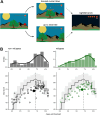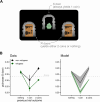Effects of Early Adversity and War Trauma on Learning Under Uncertainty
- PMID: 40778529
- PMCID: PMC12332969
- DOI: 10.1111/desc.70049
Effects of Early Adversity and War Trauma on Learning Under Uncertainty
Abstract
In uncertain situations, individuals rely on prior experiences of successes and failures to guide future decisions. Research has shown that children exposed to early adversity, such as abuse, can exhibit atypical behaviours in probabilistic learning tasks compared to peers without such experiences, which may have long-term behavioural consequences. Building on these findings, our study investigates whether children exposed to war-related trauma and forced displacement show similar alterations in decision-making under uncertainty. We conducted a series of experiments involving tasks that required learning and decision-making under uncertainty (e.g., multi-armed bandits and foraging) in Amman, Jordan, comparing Syrian refugee children (ages 7-12) with age-matched Jordanian non-refugee peers. Although our first experiment suggested less exploratory behaviour in refugee children, results from subsequent tasks revealed a pattern better explained by heightened sensitivity to rewards. This interpretation suggests that refugee children's decision-making is driven by a stronger response to rewards across different contexts. Such heightened reward sensitivity may influence how these children approach problem-solving and decision-making, potentially leading to detrimental outcomes in environments that benefit from greater exploration and the maintenance of a stable strategy. SUMMARY: Syrian refugee children (ages 7-12) showed heightened reward sensitivity compared to age-matched Jordanian peers across decision-making tasks. Reward sensitivity influenced children's choices under uncertainty, particularly following successful risky outcomes. Findings highlight how early adversity may shape decision-making strategies relevant to resilience and long-term cognitive development.
© 2025 The Author(s). Developmental Science published by John Wiley & Sons Ltd.
Conflict of interest statement
The authors declare no conflicts of interest.
Figures



Similar articles
-
Short-Term Memory Impairment.2024 Jun 8. In: StatPearls [Internet]. Treasure Island (FL): StatPearls Publishing; 2025 Jan–. 2024 Jun 8. In: StatPearls [Internet]. Treasure Island (FL): StatPearls Publishing; 2025 Jan–. PMID: 31424720 Free Books & Documents.
-
Effects of the Syrian Refugee Crisis on Public Health and Healthcare Services in Jordan: A Systematic Review.Int Nurs Rev. 2025 Jun;72(2):e70040. doi: 10.1111/inr.70040. Int Nurs Rev. 2025. PMID: 40515373
-
Flexible decision-making is related to strategy learning, vicarious trial and error, and medial prefrontal rhythms during spatial set-shifting.Learn Mem. 2024 Jul 22;31(7):a053911. doi: 10.1101/lm.053911.123. Print 2024 Jul. Learn Mem. 2024. PMID: 39038921 Free PMC article.
-
Stigma Management Strategies of Autistic Social Media Users.Autism Adulthood. 2025 May 28;7(3):273-282. doi: 10.1089/aut.2023.0095. eCollection 2025 Jun. Autism Adulthood. 2025. PMID: 40539215
-
A review on exploration-exploitation trade-off in psychiatric disorders.BMC Psychiatry. 2025 Apr 26;25(1):420. doi: 10.1186/s12888-025-06837-w. BMC Psychiatry. 2025. PMID: 40287643 Free PMC article.
References
-
- Ager, A. , and Metzler J.. 2017. “Where There Is No Intervention: Insights Into Processes of Resilience Supporting War‐Affected Children.” Peace and Conflict: Journal of Peace Psychology 23, no. 1: 67–75. 10.1037/pac0000211. - DOI
-
- Anda, R. F. , Felitti V. J., Bremner J. D., et al. 2006. “The Enduring Effects of Abuse and Related Adverse Experiences in Childhood. A Convergence of Evidence From Neurobiology and Epidemiology.” European Archives of Psychiatry and Clinical Neuroscience 256, no. 3: 174–186. 10.1007/s00406-005-0624-4. - DOI - PMC - PubMed
MeSH terms
LinkOut - more resources
Full Text Sources

